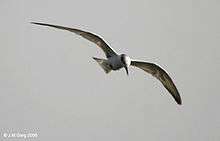Whiskered tern
| Whiskered tern | |
|---|---|
.jpg) | |
| summer plumage Kwa-Zulu Natal, South Africa | |
_winter_plumage.jpg) | |
| winter plumage Borneo, Malaysia | |
| Scientific classification | |
| Kingdom: | Animalia |
| Phylum: | Chordata |
| Class: | Aves |
| Order: | Charadriiformes |
| Family: | Sternidae |
| Genus: | Chlidonias |
| Species: | C. hybrida |
| Binomial name | |
| Chlidonias hybrida (Pallas, 1811) | |
| Subspecies | |
The whiskered tern (Chlidonias hybrida or Chlidonias hybridus) is a seabird of the tern family, Sternidae. This bird has a number of geographical races, differing mainly in size and minor plumage details.
C. h. hybrida breeds in warmer parts of Europe and Asia. The smaller-billed and darker C. h. delalandii is found in east and south Africa, and the paler C. h. javanicus from Java to Australia.
The tropical forms are resident, but European and Asian birds winter south to Africa and the Indian Subcontinent.
This species breeds in colonies on inland marshes, sometimes amongst black-headed gulls, which provide some protection. The scientific name arises from the fact that this, the largest marsh tern, show similarities in appearance to both the white Sterna terns and to Black Tern.
Description
The size, black cap, strong bill (29–34 mm in males, 25–27 mm and stubbier in females, with a pronounced gonys) and more positive flight recall common or Arctic tern, but the short, forked-looking tail and dark grey breeding plumage above and below are typically marsh tern characteristics. The summer adult has white cheeks and red legs and bill. The crown is flecked with white in the juvenile, and the hindcrown is more uniformly blackish, though in the winter adult this too is flecked with white. The black ear-coverts are joined to the black of the hindcrown, and the space above is mottled with white, causing the black to appear as a C-shaped band. The sides of the neck are white; this sometimes continues across the nape. The collar is less sharply defined. All through the year the rump is pale grey. In the juvenile, the mantle (279 mm) has a variegated pattern. The feathers of the back and scapulars are dark brown, with prominent broad buff edgings and often subterminal buff bars or centers. There is usually an admixture of new gray feathers, especially on the mantle, quite early in the fall. The mantle is silvery-gray in the adult. The call is a characteristic krekk.
In winter, the forehead becomes white and the body plumage a much paler grey. Juvenile whiskered terns have a ginger scaly back, and otherwise look much like winter adults. The first winter plumage is intermediate between juvenile and adult winter, with patchy ginger on the back.
The whiskered tern eats small fish, amphibians, insects and crustaceans.
References
- ↑ BirdLife International (2012). "Chlidonias hybrida". IUCN Red List of Threatened Species. Version 2013.2. International Union for Conservation of Nature. Retrieved 26 November 2013.
External links
- Whiskered tern - Species text in The Atlas of Southern African Birds
Various views and plumages
-

With cotton pygmy geese near Hodal in Faridabad District of Haryana, India.
-
_hunting_in_Kolleru%2C_AP_W_IMG_4014.jpg)
hunting in Kolleru Lake, Andhra Pradesh, India.
-
_in_Kolleru%2C_AP_W_IMG_4060.jpg)
in Kolleru Lake, Andhra Pradesh, India.
-
_in_Kolleru%2C_AP_W_IMG_4191.jpg)
in Kolleru Lake, Andhra Pradesh, India.
-

First-winter plumage
-
.jpg)
Adults
-
.jpg)
Adult and chick
-
| Wikimedia Commons has media related to Chlidonias hybrida. |
| Wikispecies has information related to: Chlidonias hybrida |

